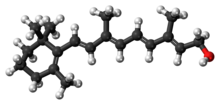Retinol metabolism
 |
|

Retinol
|
|
| Clinical data | |
|---|---|
| AHFS/Drugs.com | Monograph |
| Pregnancy category |
|
| Routes of administration |
by mouth, IM |
| Drug class | vitamin |
| ATC code | |
| Legal status | |
| Legal status |
|
| Identifiers | |
|
|
| CAS Number | |
| PubChem CID | |
| IUPHAR/BPS | |
| ChemSpider | |
| UNII | |
| ChEBI | |
| ChEMBL | |
| ECHA InfoCard | 100.000.621 |
| Chemical and physical data | |
| Formula | C20H30O |
| Molar mass | 286.4516 |
| 3D model (JSmol) | |
| Melting point | 62–64 °C (144–147 °F) |
| Boiling point | 137–138 °C (279–280 °F) (10−6 mm Hg) |
|
|
|
|
Retinol, also known as Vitamin A1, is a vitamin found in food and used as a dietary supplement. As a supplement it is used to treat and prevent vitamin A deficiency, especially that which is resulting in xerophthalmia. In areas where deficiency is common a single large dose is recommended to those at high risk a couple of times a year. It is also used to prevent further issues in those who have measles. It is used by mouth or injection into a muscle.
Retinol at normal doses is well tolerated. High doses may result in an enlarged liver, dry skin, or hypervitaminosis A. High doses during pregnancy may result in harm to the baby. Retinol is in the vitamin A family. It or other forms of vitamin A are needed for eyesight, maintenance of the skin, and human development. It is converted in the body to retinal and retinoic acid through which it acts. Dietary sources include fish, dairy products, and meat.
Retinol was discovered in 1909, isolated in 1931, and first made in 1947. It is on the World Health Organization's List of Essential Medicines, the most effective and safe medicines needed in a health system. Retinol is available as a generic medication and over the counter. The wholesale cost in the developing world is about 0.02 to 0.30 USD per 50,000 units. In the United States it is not very expensive.
Retinol is used to treat vitamin A deficiency.
...
Wikipedia
